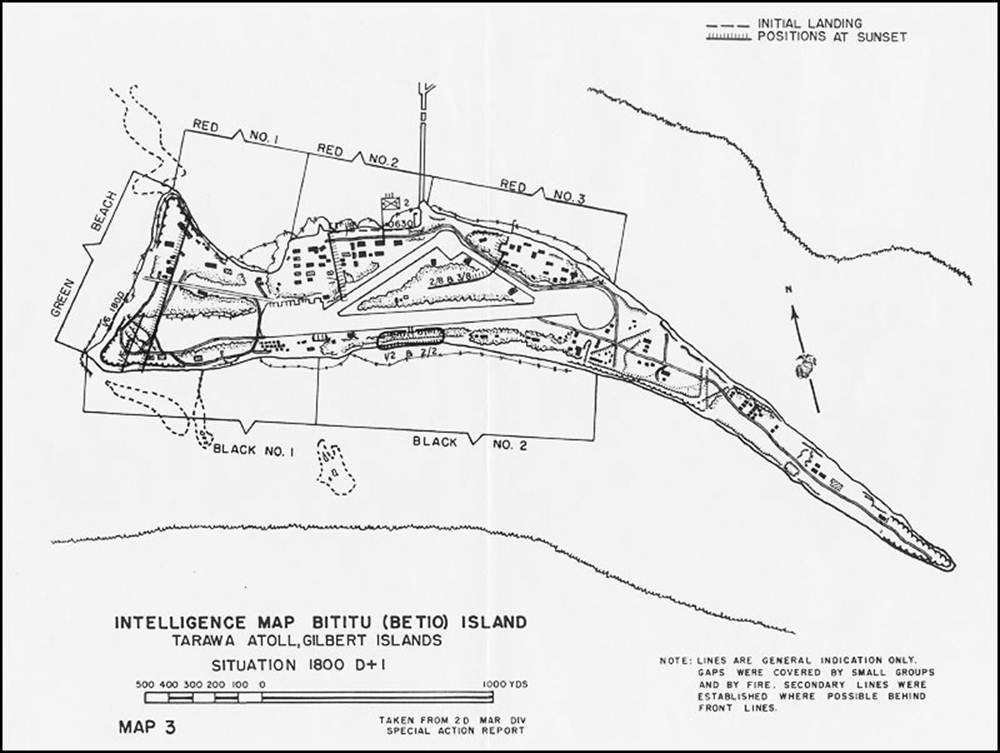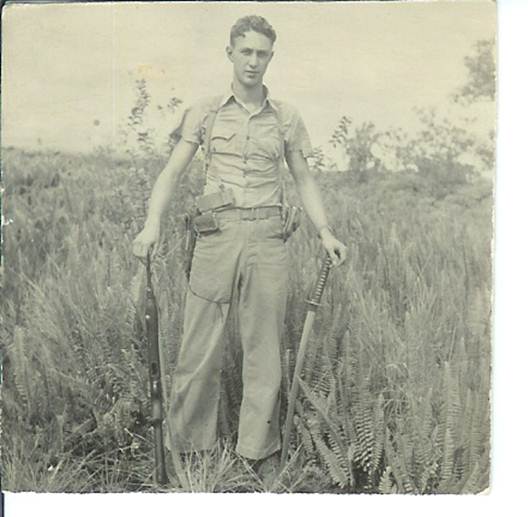|
THE
BATTLE
FOR TARAWA AND
TARAWA
AND
THE SAMURAI SWORD
By Robert D. Runyard
My story of the
Samurai Sword takes place on the second day of the battle for
Tarawa
in the
Gilbert Islands
. The initial landing of the
SECOND MARINE DIVISION, took place on
November 20th, 1943
on
Betio
Island
, TARAWA ATOLL, in the
Gilbert Islands
. In order for you to
better understand the situation on the second day I have included below
a
part of the official historical account of the situation on the evening
of D-Day, on the
island
of
Betio
, Tarawa Atoll. You
can read the entire account at http://www.ibiblio.org/hyperwar/USMC/USMC-M-Tarawa/
. From the web
site map, you will see our positions as shown by the blue lines.
Most of the island was held by the Japanese.
FROM THE
WEB
SITE
The First Day,
20 November 1943
Evening D-Day
As
darkness fell on Betio, the situation of the Marines of the 2d Marine
Division ashore was precarious. On the left of the beachhead (looking
south) was the 2d Battalion, 8th Marines, whose left flank
was anchored on the beach just short of the Burns-Philp pier. A part of
the battalion landing team was in the eastern portion of the triangular
area enclosed by the air strip and its taxiways. Helping to hold the
line with the 2d Battalion, 8th Marines, was that part of the
3d Battalion, 8th Marines which had reached the shore during
the afternoon. Next on the beachhead line, and on the right of Crowe’s
battalion, were the troops of the 1st and 2d Battalion, 2d
Marines. There was no continuous line; the defensive perimeter was held
by small groups of men who occupied shell holes and covered positions in
the western part of the before-mentioned triangular area. The positions
continued in a northerly direction from the west taxiway over to about
the center of RED
2. The ground west of these positions remained in Japanese hands, except
for the foothold on the northwestern tip where Maj. “Mike” Ryan and
the mixed troops under his command were dug in for the night. Most of
the work done during the afternoon had been directed toward expanding
the initial positions of the assault troops and in attempting to join
contact in order to form a defensive perimeter by sundown. Most of the
Marines prepared for the night with the feeling that a Japanese
counterattack was inevitable. Even out on the control vessels and on the
ships in the transport area, there was a restless feeling that any
moment during the night, reports would come in saying that the Japanese
were attempting to force the Marines back into the sea. Despite the
universal apprehension, there was no counterattack. The first night
ashore on Betio saw remarkable fire discipline. There was no promiscuous
shooting. What little firing was done happened only when wandering
Japanese stumbled near the fox holes of the Marines. Out on the
Maryland
the staff of the division listened for reports of rifle fire announcing
an enemy counterattack. They were relieved when the night passed
quietly.
MY
STORY PICKS UP BELOW:
The
morning of the second day I was located in the center area, but we had
men from our intelligence section attached to units that landed to the
west, or left hand side of the map. We
had not heard from any of them; and I was ordered to see if I could make
contact. Neither my unit
commander, nor myself, knew that the enemy still held that large portion
between our lines.
As
I moved west I noted that I was alone, and became a bit apprehensive,
but there was no firing nearby; so I proceeded.
I saw a few dead Marines and enemy dead, but still no one alive.
After a short while I came upon a dead Marine body with no head.
A few feet away I found his helmet with only brains filling it.
It was not a nice sight, but by that time I had seen so many dead
from both sides that such things did not bother me too much.
Moving
further I suddenly heard rifle fire ahead of me, and looking in that
direction, I saw three Japs running in my general direction, but not
directly towards me, and they were not the ones firing.
I ducked behind a palm tree and watched as they disappeared
behind a bomb proof. I then
saw three Marines approaching the bomb proof and I came out from behind
the tree and proceeded towards them.
Arriving
at the bomb proof I could see that the Japs had escaped into the
entrance. Also they had
dropped a samurai sword and a pistol at the entrance.
Very soon a Marine with a flame thrower showed up, and standing
slightly to the side of the entrance he aimed the flame thrower at the
entrance and fired it. Only
a short burst of flame came out. Not
enough to even reach the entrance.
He said he was short of – I think he said nitrogen, and
took off to refill it.
In
the mean time the four of us took up positions on the top of the bomb
proof where we could see the entrance.
I hated to see the sword and pistol destroyed by the flame
thrower; so I suggest to one fellow that he cover me. Told him I would
give him the pistol. I
wanted the samurai sword. He
agreed and I crept close to the entrance, pulled the pin of a grenade,
let the handle fly off, held it for a second and then threw it in.
As soon as the dust cleared enough for me to see, I grabbed the
sword and pistol and went back up on top of the bomb proof.
The
guy with the flame thrower came back.
We moved away from above the entrance and he gave it a good long
shot. Bomb proofs have right
angle turns in the passage; so it is unlikely whether my grenade or the
flame got to the Japs. The
flame eats up all the oxygen and they suffocate.
I
learned from all of this that the area was not secure; so I returned to
my unit and reported what I had learned.
I still have that samurai sword.
Bob
Runyard
A
TARAWA
BATTLE
MAP
APPEARS BELOW
A
PICTURE OF MYSELF
WITH SAMURAI SWORD IS ON THE
NEXT
PAGE

THE
LANDING ON
TARAWA
BEGAN ON NOV. 20TH,1943
AND
ENDED 76 HOURS LATER.
THE
PICTURE BELOW WAS TAKEN ON THE BIG
ISLAND
OF
HAWAII
SOME TIME IN DECEMBER , 1943.
THE SHIRT SHOWN WAS NOT
BATTLE
DRESS. WE WORE DUNGAREE
JACKETS WITH THE DUNGAREE PANTS SHOWN.
THE
SABER I AM HOLDING IS THE SAMURAI SWORD NOTED IN THE ABOVE STORY.
I AM NOT SURE WHY MY PISTOL BELT WAS NOT BUCKLED .
THE
HAND
OVER THE RIFLE MUZZLE IS NOT A RECOMMENED PRACTICE.

CORPORAL
ROBERT D. RUNYARD, USMC
DECEMBER,
1943
BIG
ISLAND
,
HAWAII
BACK

Updated 09/22/2012 |